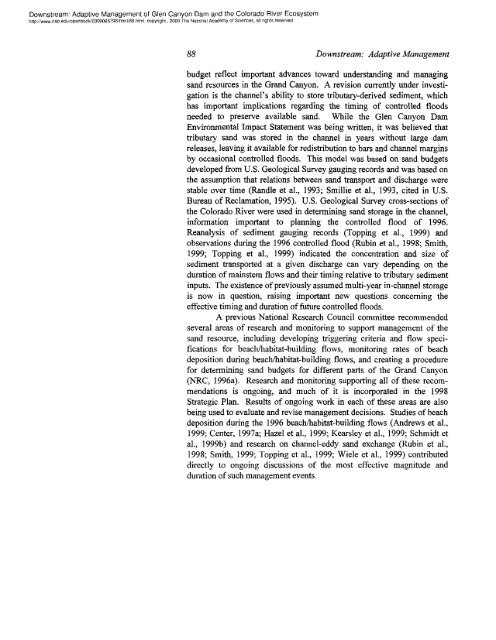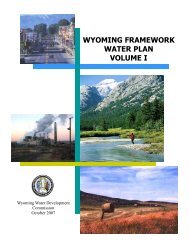Glen Canyon Dam adaptive management program. - Living Rivers
Glen Canyon Dam adaptive management program. - Living Rivers
Glen Canyon Dam adaptive management program. - Living Rivers
You also want an ePaper? Increase the reach of your titles
YUMPU automatically turns print PDFs into web optimized ePapers that Google loves.
Downstream- Adaptive Management of <strong>Glen</strong> <strong>Canyon</strong> <strong>Dam</strong> and the Colorado River Ecosystem<br />
http //www nap edu/openbook/0309065798/html/88 html copyright , 2000 The National Academy of Sciences, all rights reserved<br />
88 Downstream: Adaptive Management<br />
budget reflect important advances toward understanding and managing<br />
sand resources in the Grand <strong>Canyon</strong>. A revision currently under investigation<br />
is the channel's ability to store tributary-derived sediment, which<br />
has important implications regarding the timing of controlled floods<br />
needed to preserve available sand. While the <strong>Glen</strong> <strong>Canyon</strong> <strong>Dam</strong><br />
Environmental Impact Statement was being written, it was believed that<br />
tributary sand was stored in the channel in years without large dam<br />
releases, leaving it available for redistribution to bars and channel margins<br />
by occasional controlled floods. This model was based on sand budgets<br />
developed from US. Geological Survey gauging records and was based on<br />
the assumption that relations between sand transport and discharge were<br />
stable over time (Handle et al., 1993; Smillie et al., 1993, cited in U.S.<br />
Bureau of Reclamation, 1995). U.S. Geological Survey cross-sections of<br />
the Colorado River were used in determining sand storage in the channel,<br />
information important to planning the controlled flood of 1996.<br />
Reanalysis of sediment gauging records (Topping et a]., 1999) and<br />
observations during the 1996 controlled flood (Rubin et al., 1998; Smith,<br />
1999; Topping et al., 1999) indicated the concentration and size of<br />
sediment transported at a given discharge can vary depending on the<br />
duration of mainstem flows and their timing relative to tributary sediment<br />
inputs. The existence of previously assumed multi-year in-channel storage<br />
is now in question, raising important new questions concerning the<br />
effective timing and duration of future controlled floods.<br />
A previous National Research Council committee recommended<br />
several areas of research and monitoring to support <strong>management</strong> of the<br />
sand resource, including developing triggering criteria and flow specifications<br />
for beachhabitat-building flows, monitoring rates of beach<br />
deposition during beachhabitat-building flows, and creating a procedure<br />
for determining sand budgets for different parts of the Grand <strong>Canyon</strong><br />
(NRC, 1996a). Research and monitoring supporting all of these recommendations<br />
is ongoing, and much of it is incorporated in the 1998<br />
Strategic Plan. Results of ongoing work in each of these areas are also<br />
being used to evaluate and revise <strong>management</strong> decisions. Studies of beach<br />
deposition during the 1996 beachlhabitat-building flows (Andrews et al.,<br />
1999; Center, 1997a; Hazel et al., 1999; Kearsley et al., 1999; Schmidt et<br />
al., 1999b) and research on channel-eddy sand exchange (Rubin et al.,<br />
1998; Smith, 1999; Topping et al., 1999; Wiele et al., 1999) contributed<br />
directly to ongoing discussions of the most effective magnitude and<br />
duration of such <strong>management</strong> events.
















